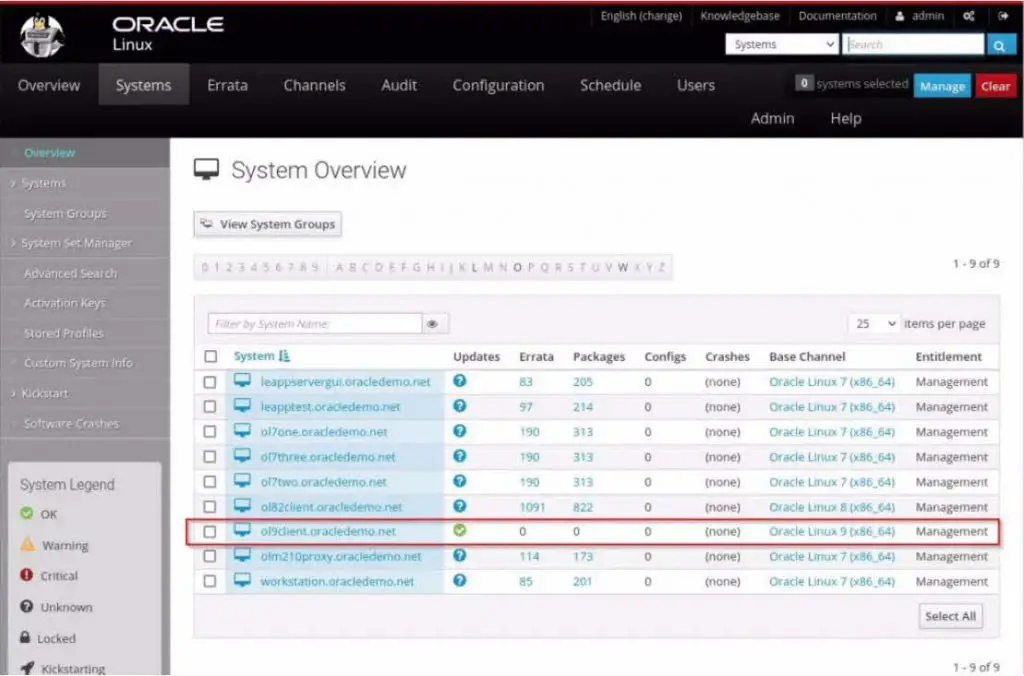Oracle Linux Manager 2.x, Free Linux Management
I am really fan of what is doing Oracle for Oracle Linux and offering open-source solutions with free update. Oracle Linux Manager is one of free and open-source solutions that Oracle provides for Oracle Linux by developing new enterprise solution from open-source solutions.
Space Walk Become Oracle Linux Manager
A central task for IT administrators is to provision systems and keep them up to date with the latest patches and operating system updates. If the security policy at your site mandates errata as critical, it is crucially important to conduct regular testing and apply patches to reduce the risk of systems compromise or data exposure. As data centers expand, administrators are required to manage even greater numbers of physical servers and virtual machines. As a result, automation becomes a necessity for efficient and cost-effective systems management.
Oracle Linux Manager 2.10, based on the Spacewalk open source software, helps automate Oracle Linux systems management, thereby enabling you to control the system software life cycle, from initial installation, through maintenance, software configuration, upgrades, and eventual decommissioning.
Provisioning and maintaining large numbers of physical servers and virtual machines across large deployments that span departments and data centers is a challenging task. However, keeping Oracle Linux systems up to date with stable software configurations, the latest security errata, and consistent patch levels is critical to user productivity, as well as useful for managing day-to-day business operations.
This guide introduces you to the basic concepts of using that to manage Oracle Linux systems. Beyond the scope of this guide are additional efficiencies that can result from implementing that.
For example, you can use it to do the following:
- Run automatic OpenSCAP audits against industry-standard security checklists and evaluation profiles.
- Use the Spacewalk API, which offers powerful and extensive interfaces for high-level scripting, to provide a sophisticated and comprehensive way to automate advanced management tasks.
Oracle Linux Manager provides an effective set of tools for managing the Oracle Linux software life cycle in small or large deployments. Oracle Linux Manager also helps you automate a kickstart installation, system configuration, and maintenance tasks, which enables you to rapidly deploy proven and consistent software configurations for Oracle Linux systems.
As illustrated in the following figure, during the typical life cycle of a system, you can use it to simplify several system management tasks, such as installing bare metal systems and virtual guests, applying patches and software updates, configuring software, and auditing system security.
You can administer and perform most operations by using either a web interface or the spacecmd command. Oracle Linux Manager also features an extensive and powerful XML/RPC-based API that you can use with a high-level scripting language such as Python.
Oracle Linux Premier Support and Oracle Linux Basic Support contracts provide support for Oracle Linux Manager and include a limited-use license for Oracle Database Enterprise Edition for use with Oracle Linux Manager. You can use Oracle Linux Manager to automate the management of Oracle Linux 6, Oracle Linux 7, and Oracle Linux 8 systems. When deployed on Oracle Linux, Oracle Linux Manager can additionally manage other Linux releases, such as CentOS, Debian, Fedora, and SLES. However, note that Oracle does not support Oracle Linux Manager for management of these systems.
That provides automated management capabilities at no additional cost. Oracle support for Oracle Linux Manager is especially valuable when transitioning to Oracle Linux, for those who are already familiar with Red Hat Satellite 5 releases or SUSE Manager.
Oracle Linux Manager Architecture
The following figure depicts an internal, three-tiered server architecture.
The server architecture includes the following three tiers:
- Data tier: Contains the database and Taskomatic. Oracle Linux Manager uses the Taskomatic daemon to perform asynchronous scheduled tasks, such as resynchronizing software channels, applying software and configuration updates to clients, and notifying you when new errata become available.
- Logic tier: Contains the Apache and Tomcat web servers, which process data for use by the presentation tier.
- Presentation tier: Contains the back-end and front-end XML/RPC APIs, which provide programming interfaces for the command-line client utilities and other XML/RPC clients, and the web interface, which can be accessed by using a web browser.
That uses a distributed client-server architecture, in which registered client systems subscribe to the software channels that an Oracle Linux Manager server hosts. You can distribute server functionality across as many systems as are required to meet your organization’s needs. This capability is especially useful for organizations that are distributed across several geographical regions.
For example, a simple deployment might have a single primary server to serve a pool of client systems, along with a proxy server to offload processing from the primary so that you can support more client systems. In larger deployments, you can configure multiple Oracle Linux Manager primary servers and proxy servers to improve provisioning and software download speeds. In a distributed configuration, clients are likely to have higher network bandwidth access to servers that are within close proximity.
Conclusion
Managing hundred Linux servers become a trouble for any administration team. Oracle Linux Manager will help you to manage your enterprise Linux servers such as Oracle Linux, CentOS and others.
Also it’s totally free to use and there is no cost for updating and managing your Linux servers.
Further Rading
Oracle Linux Virtualization Manager
What’s HPE OneView Global Dashboard?
Run Remote Command On Multiple Clients By Secure Shell And PowerShell











